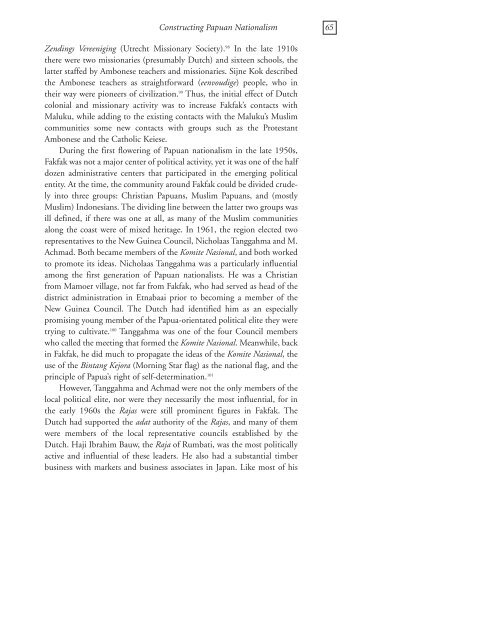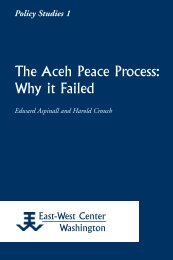Constructing Papuan Nationalism: History, Ethnicity ... - ScholarSpace
Constructing Papuan Nationalism: History, Ethnicity ... - ScholarSpace
Constructing Papuan Nationalism: History, Ethnicity ... - ScholarSpace
- No tags were found...
Create successful ePaper yourself
Turn your PDF publications into a flip-book with our unique Google optimized e-Paper software.
<strong>Constructing</strong> <strong>Papuan</strong> <strong>Nationalism</strong> 65Zendings Vereeniging (Utrecht Missionary Society). 98 In the late 1910sthere were two missionaries (presumably Dutch) and sixteen schools, thelatter staffed by Ambonese teachers and missionaries. Sijne Kok describedthe Ambonese teachers as straightforward (eenvoudige) people, who intheir way were pioneers of civilization. 99 Thus, the initial effect of Dutchcolonial and missionary activity was to increase Fakfak’s contacts withMaluku, while adding to the existing contacts with the Maluku’s Muslimcommunities some new contacts with groups such as the ProtestantAmbonese and the Catholic Keiese.During the first flowering of <strong>Papuan</strong> nationalism in the late 1950s,Fakfak was not a major center of political activity, yet it was one of the halfdozen administrative centers that participated in the emerging politicalentity. At the time, the community around Fakfak could be divided crudelyinto three groups: Christian <strong>Papuan</strong>s, Muslim <strong>Papuan</strong>s, and (mostlyMuslim) Indonesians. The dividing line between the latter two groups wasill defined, if there was one at all, as many of the Muslim communitiesalong the coast were of mixed heritage. In 1961, the region elected tworepresentatives to the New Guinea Council, Nicholaas Tanggahma and M.Achmad. Both became members of the Komite Nasional, and both workedto promote its ideas. Nicholaas Tanggahma was a particularly influentialamong the first generation of <strong>Papuan</strong> nationalists. He was a Christianfrom Mamoer village, not far from Fakfak, who had served as head of thedistrict administration in Etnabaai prior to becoming a member of theNew Guinea Council. The Dutch had identified him as an especiallypromising young member of the Papua-orientated political elite they weretrying to cultivate. 100 Tanggahma was one of the four Council memberswho called the meeting that formed the Komite Nasional. Meanwhile, backin Fakfak, he did much to propagate the ideas of the Komite Nasional, theuse of the Bintang Kejora (Morning Star flag) as the national flag, and theprinciple of Papua’s right of self-determination. 101However, Tanggahma and Achmad were not the only members of thelocal political elite, nor were they necessarily the most influential, for inthe early 1960s the Rajas were still prominent figures in Fakfak. TheDutch had supported the adat authority of the Rajas, and many of themwere members of the local representative councils established by theDutch. Haji Ibrahim Bauw, the Raja of Rumbati, was the most politicallyactive and influential of these leaders. He also had a substantial timberbusiness with markets and business associates in Japan. Like most of his
















